Trends, Schemes & Analysis: Defense
Jim Comparoni | Publisher
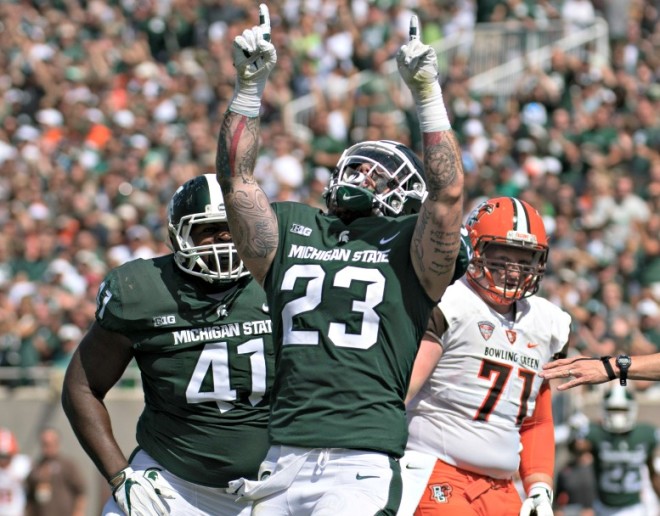
Chris Frey celebrates strong defensive play in week one against Bowling Green. (photos by Alan Holben)
EAST LANSING - Was Michigan State’s defensive showing againstBowling Green reason to believe the Spartans are close to being back to the dominant ways of the glory days of the Mark Dantonio era?
Not quite. Not yet.
But it wasn’t a bad start, and a decent step heading into next week’s challenging visit from Western Michigan. The Broncos generated 357 yards and 31 points in a 49-31 loss at USC on Saturday.
“I thought our defense played outstanding,” Dantonio said. “They were two out of 15 on third or fourth downs which is huge. They couldn't run the football, and had about 45 yards rushing until the last series and had about 100 yards passing (actually 145). We played extremely well on defense.”
The Spartans held Bowling Green to 212 yards of offense and nine first downs.
The positives:
* Michigan State was quick and firm up the middle, with a rotation of defensive tackles playing well, down-in and down-out, and a new middle linebacker in Joe Bachiehandling the interior like a veteran.
* The Spartans played more man-to-man defense than their usual mode of operation from previous years, and did so with envelope-pushing contact and physicality during routes and when the ball was in the air - all while avoiding any pass interference penalties.
The negatives:
* Michigan State allowed receivers to get open deep on two occasions, maybe three. Starting cornerback Josh Butler allowed a 45-yard pass to 6-foot-5 Datrin Guyton on Bowling Green’s opening drive. The Falcons looked to go deep to Guyton on at least two other occasions, including one against Justin Layne but couldn’t hook up.
Layne, who otherwise had a strong game, allowed Guyton to get a step on him on a deep shot on third-and-eight in the first quarter, but Layne showed good make-up speed as an inaccurate pass fell incomplete. A perfect pass, like the one Morgan threw on the 45-yarder, would have been catchable for Guyton. He still had a half-step lead on Payne by the time the ball arrived.
All-MAC wide out Scott Miller beat Khari Willis deep from the slot area on fourth-and-two in the first half, but Falcons quarterback James Morgan sailed the ball out of bounds, and Miller dropped it anyway.
Bowling Green tried to go deep a handful of times after their initial success on the opening drive, but the Falcons were never able to execute. Michigan State rolled four cornerbacks into the game, and each of them were tested deep.
Overall, Dantonio gave the DBs a passing grade.
“I thought we played well defending the ball down the field,” Dantonio said. “I thought our corners played very well.”
Said co-defensive coordinator Mike Tressel:
“We gave up a couple plays, which will happen obviously when you're going against any offense who are going to make a couple plays. Everybody remained calm, there was no panic, they stayed together, that's what I was most excited to see.”
* Michigan State had only four penalties on this day, but an off-sides by Chris Frey on a third-and-seven incompletion gave the Falcons an extra snap on third-and-two. Frey made an error on the third-and-two, as well, when he was a step late in recognizing the fullback (his responsibility) sneaking past him and into the open over the middle. Morgan missed the fullback with his throw, otherwise Frey would have been responsible for back-to-back errors.
Frey made up for it with a strong second half, punctuated by the sack. One snap prior to the sack, he played the point on a zone run to his side and stacked it up like a plus player.
The neutrals:
* In terms of pass rush, the good news is thatFrey - who has had trouble getting home on blitzes earlier in his career - corralled Morgan for a sack as part of a four-man rush on the second series of the second half.
One sack a game is the same rate Michigan State had last year (12 sacks on the year) in fielding one of the least-productive pass rushes in the country.
One sack against the Falcons was worth celebrating at the time, but nothing to plant a flag over.
However, Michigan State amassed eight quarterback hurries, not a bad number, from eight different players: Frey, defensive end Kenny Willekes, defensive tackle Naquan Jones, Layne, Demetrious Cooper, Raequan Williams and Brandon Randle.
Williams’ pressure came on a third-and-five situation to help stifle Bowling Green’s opening drive, forcing a field goal attempt after the 45-yard completion had put Michigan State on its heels for a moment.
“I thought we had a couple more opportunities to have a few more sacks, but the motor was good,” said Tressel. “The pressure was much better. No doubt about it, it is improved. We'd like to get that quarterback on the ground a few more times.”
PASS RUSH: YOU MIGHT NOT HAVE NOTICED …
In addition to the sack and the hurries, Michigan State also drew a holding penalty via a new pass rush package on a third-and-seven late in the first half.
Michigan State showed a new defensive front for this play, with only two down linemen. Aside from the old occasional Narduzzi “chaos” package, Michigan State has ALWAYS gone with three down linemen as part of the nickel defense in passing situations.
This time, they switched it up with only two down linemen AND positioned the two down linemen all the way to the QB’s right side.
The alignment went like this:
* Frey standing up in a wide nine at left end, to the QB’s right.
* Next to Fry, Demetrius Cooper was a traditional defensive end over the C-gap.
* Next to Cooper, Raequan Williams was a traditional three-technique over the B-gap.
Cooper and Williams were the only players in a three-point stance (as “down” linemen).
Inside, there was NO ONE over the A-gaps at pre-snap, although Joe Bachie hovered around at the linebacker depth.
To the field side, redshirt freshman linebacker Brandon Randle lined up in a two-point stance in the C-gap, over the left tackle.
This alignment, with the dense pack of Frey, Cooper and Williams to the boundary side, basically guaranteed that Randle would get single-coverage on the field side. That’s what Michigan State wanted.
Randle sprang quickly with a good (not great) take-off. He can do better.
But he was quick enough with the take-off, and a brief fake fake to the inside, that when he countered fast back to the outside, Falcons left tackle Ryan Hunter panicked and grabbed him with his left arm. Hunter was flagged for holding.
(Away from that action, Michigan State ran an array of slants that resulted in all of the gaps getting filled, despite the initial imbalance. Bachie ended up joining the rush as a blitzer. Williams slanted from the boundary B across the faces of two offensive linemen all the way over the field A-gap. Williams wasn’t necessarily the featured man for this pressure, but his slant to the inside closed the gate in case of an unlikely draw play or QB run).
Michigan State coaches said they had been cooking up some new schemes to feature their talent better than they did a year ago in the pass rush. Well, this alignment and scheme was new. And it did feature Randle’s edge athleticism.
[By the way, third-string linebacker Shane Jones was on the field for this package, too. He’s not an every-down guy, and maybe not a prototypical pass defender. But he was tasked with threatening an inside blitz at pre-snap, and then dropped into short-area coverage with QB spy responsibilities and then short-area pass defense. When SpartanMag described Jones as being a “special ops” type of candidate, this is what we were talking about. Michigan State likes to give bit roles to third-string players in special ops, not to be confused with special teams.]
**
Post Script: While Randle was being held, the Falcon quarterback was able to attempt a pass, throwing incomplete for his split end on a short return route. Layne was in coverage on this play, and allowed a little too much separation on the short, angled return route, but the QB missed him.
PSS: Later in the game, Randle (6-2, 231, Battle Creek) displayed a nice spin move in registering a QB hurry.
“I was excited that we got probably six or seven defensive ends, six defensive tackles, seven linebackers, probably eight defensive backs all in, in early time, first three quarters,” Tressel said. "We were hoping we had a lot of guys that would be able to help us in critical situations, and we got to play a lot."
RISING RESERVES
Second-string safety David Dowell and second-string cornerback Josiah Scott were among the most impressive non-starters on defense for Michigan State.
Scott, a true freshman, had two pass break-ups and played sticky in coverage most of the day. He served as a first-stringer for part of August camp, but lost first-string status partly due to an undisclosed injury.
Butler, a redshirt sophomore, started the game in place of Scott on Saturday, and Butler also started the second half. Scott is supportive of his older teammate and is comfortable in his reserve role. But if Scott keeps improving, Butler will need to hustle in order to retain starting status. This appears to be a healthy situation for MSU for the long term.
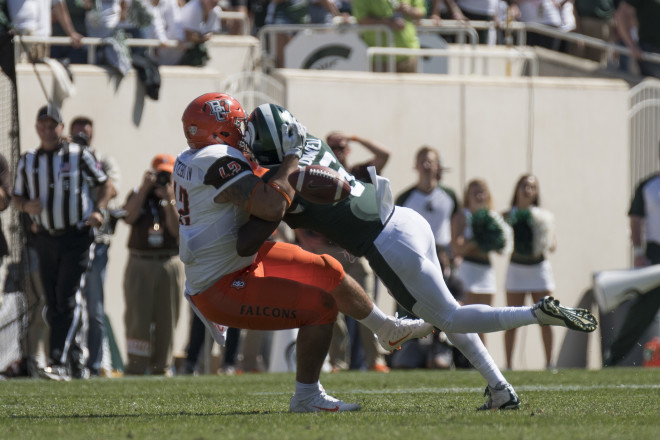
David Dowell lays a heavy hith on 258-pound Bowling Green fullback Leonard Skattebo.
Dowell had two pass break-ups, delivered a heavy hit, and dropped what could have been a pick-six.
Dropping a potential interception is a negative in some ways, but this guy plays quick, and increasingly smart, which put him in position to have a chance for a pick-six. There's value in that.
Dowell is playing behind Willis. Willis is a leader and a sturdy tackler. Willis is playing with more knowledge than ever, and is a step quicker to the scene - however he isn't the fastest DB in the world.
Michigan State played press coverage across the board, most of the game. That means the Spartans not only played press coverage at cornerback, which has been commonplace for Michigan State over the years, the Spartans also played press coverage in the slot area with the nickel back. Michigan State has rarely done this in the past. The only times Michigan State has pressed slot receivers in the past has been in end-game situations or red zone situations, and rarely at that.
But Michigan State pressed the slot area several times in the early going of this game, signifying some of the changes Spartan coaches have talked about in terms of reducing some of the predictability of their base defense.
When Bowling Green coaches saw that the Spartans were pressing the slot area, and doing it with Willis, the Falcons called time out prior to a fourth-and-two play midway through the first half and put standout WR Scott Miller in the slot to attack Willis on a go route. Miller beat Willis off the line of scrimmage and was open by a step-and-a-half heading toward the end zone. Morgan’s pass fell incomplete, but MSU’s vulnerability in trying to play press coverage with Willis on slot receivers was evident on that play.
If Michigan State continues to opt for press coverage in the slot, one wonders when Dowell might emerge as the best-equipped player to provide that duty. Dowell, a former cornerback, is on the rise as a candidate at safety.
**
Reserves who were noticed winning football at first glance included Scott and Tyson Smith at CB, Dowell at safety, Cooper at defensive end, Randle at rush end, Shane Jones at LB, Gerald Owens at d-tackle and Naquan Jones at d-tackle. We’ll have to take a closer look at LB Byron Bullough, safety Grayson Miller, LB Tyriq Thompson, DT Devyn Salmon, DE Jacub Panasiuk and DT Kyonta Stallworth, but they all looked functional at the least.
ELITE REMNANTS
Michigan State is not the elite team it was from 2013 to ’15. Part of the changeover in the last season-and-a-half has been an increased reliance on non-redshirted players, while freshmen and sophomore have risen to important roles, perhaps earlier than would be the case if the roster were as deep and mature as it was in the championship years.
When the Spartans were rolling to championships, they often had standout players such as Darien Harris, Denicos Allen, Joel Heath and Shilique Calhoun redshirt and wait until their third or even fourth year in the program (in Harris’ case) before they started becoming impact players.
Michigan State doesn’t have that kind of veteran depth at every position, but there are still some reserve areas that have a championship feel.
Examples:
+ Naquan Jones’ athletic, hustling pursuit during a middle screen in the second quarter.
The 6-foot-4, 328-pound teen-ager pressed the middle and then sprinted to the ball, showing “who’s that guy?” speed. He arrived at the receiver at full bore and put a good lick on him at the end of a 3-yard gain
That’s what redshirt freshman back-up defensive tackles look like for powerful programs.
+ His tag team partner for the day, Gerald Owens, has been invisible for three-and-a-half years in making the transition from being a hefty tailback to a defensive lineman. He was a little slow to buy into the idea of becoming a d-lineman. But now he’s on board, and he’s playing functional football as a second-string defensive tackle, bordering on winning football.
Having to wait four years to get on the field as a second-stringer, and then looking like a quality player when he get his chance - that’s what happens at championship programs.
+ On one noticeable occasion, Salmon provided push vs. the Bowling Green center on an inside zone run late in the first half. Salmon reset the line of scrimmage and created room for Bachie to press forward and stuff the tailback for no gain.
After that play, Salmon checked out immediately as Michigan State quickly subbed its nickel defense onto the field. All 327 pounds of Mr. Salmon leaped up from the pile and excitedly hopped and skipped to the sideline for pats on the head, a happy Spartan Dawg.
A senior at that size, playing with that kind of force as a third-stringer, getting on the field for the first time in his career? That’s the type of thing that happens at championship programs.
The fact that Michigan State used three groups of defensive tackles as part of the regular playing group - that’s the type of thing championship programs are capable of doing.
+ And how about Shane Jones’ punishing hit on Falcons running back Josh Cleveland on a second-and-10 in the second quarter, moments after Michigan State took a 7-3 lead? Jones’ hit was a tone-setting play that helped swing momentum in Michigan State’s favor for good.
Jones saw playing time in third-down situations in this game, but he’s basically a third-string linebacker, behind Bachie and Byron Bullough at middle linebacker, and behind Frey and Tyriq Thompson at money linebacker. After this game, he might nudge back ahead of Bullough again. But the point is that he is an experienced fifth-year senior, who has started three games in the past. He might be carrying a little too much weight, but he’s about to turn 23-years-old and is playing with man strength.
A veteran like Jones, with his maturity and knowledge of the game, coming off the bench as a playing-group second- or third-stringer? That’s the type of thing you see with championship programs.
* On offense, a junior with the horsepower of Matt Sokol has had to wait four years to become a fixture in the offense at tight end - that’s what happens at championship programs. And the hit he made on kickoff coverage at the outset of the first half, running alongside senior Gerald Holmes in that role? Championship example.
* Madre London, after three years of intermittent use at tailback including a redshirt year, emerging from the third string to provide turning-point plays as a ball carrier in this game? He has had to wait due to strong talent at his position, and heavy competition - which are unmistakable signs of a championship program.
* Darrell Stewart has had to wait until his third year to become a regular in the playing group, and he did so on Saturday as the best player on the field. That’s very Ohio State or Alabama of him.
POST SCRIPT: Don’t get it twisted. Bowling Green was merely a sparring partner. Michigan State is thin and questionable in too many areas to be considered a championship team at this time, especially while playing in the toughest conference division in America. But there are still some healthy areas in the program, and they were noticeable in the season opener.
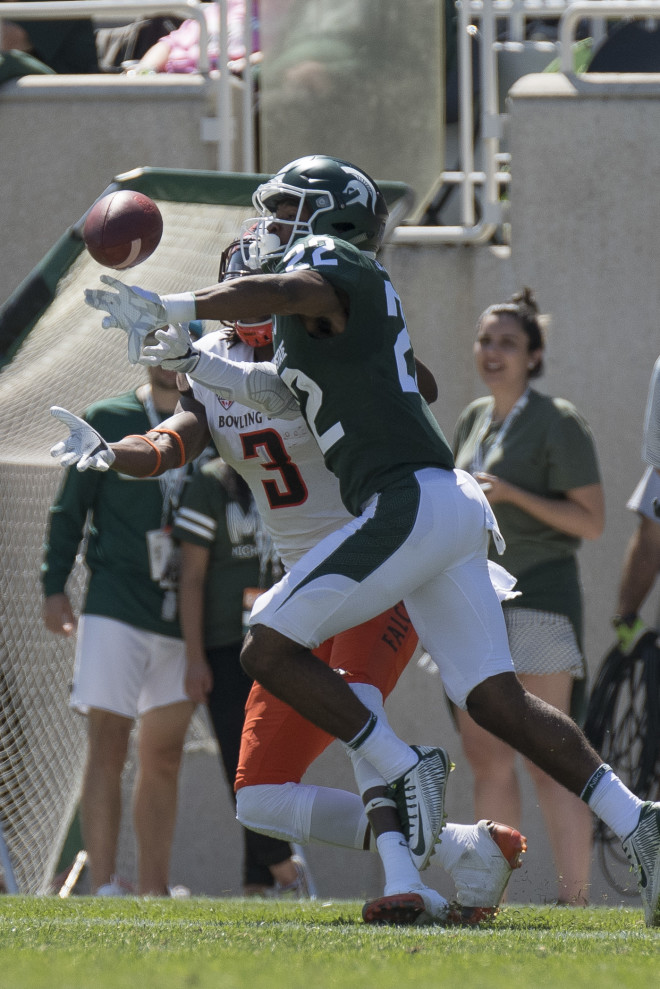
Josiah Scott with a pass break-up.
Photos by Alan Holben
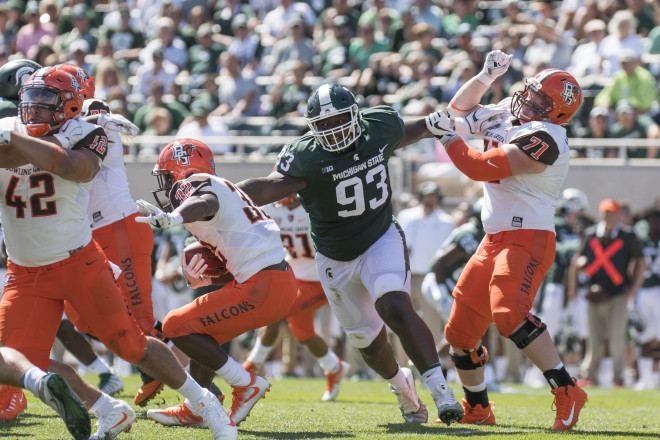
Naquan Jones made an impact in his Michigan State debut as a second-string defensive tackle.
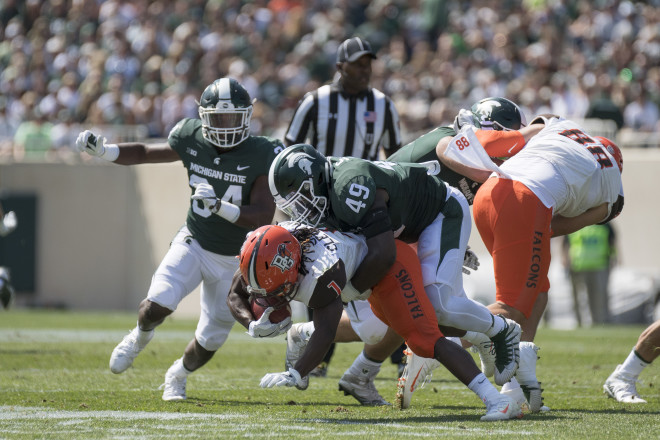
Shane Jones played with toughness in a reserve role.
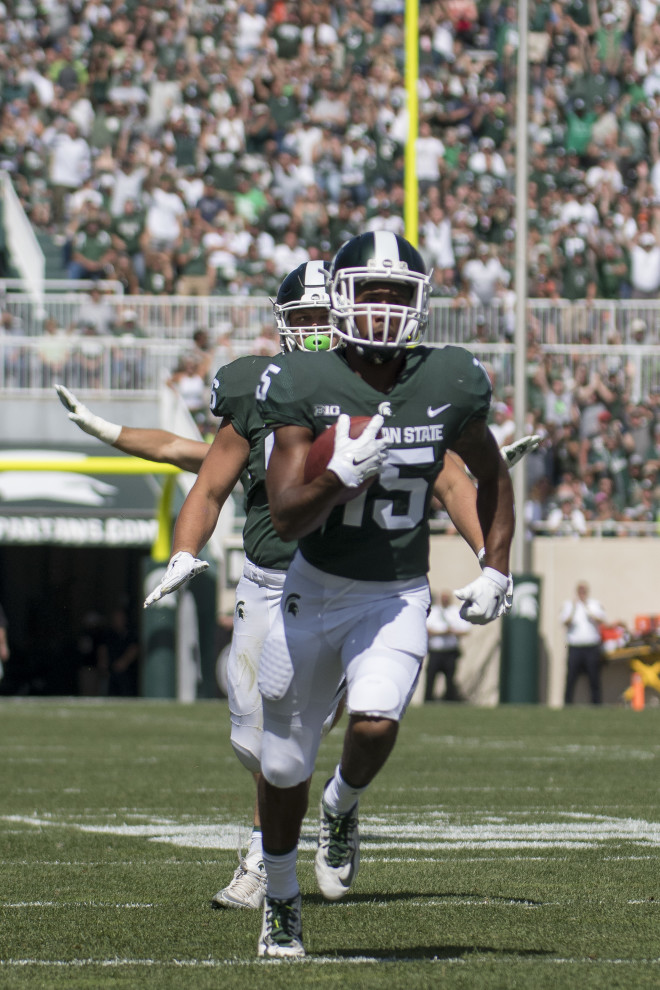
Tyson Smith made national news with his pick-six in the season opener, his first game back since suffering a stroke last November.
Jim Comparoni | Publisher

Chris Frey celebrates strong defensive play in week one against Bowling Green. (photos by Alan Holben)
EAST LANSING - Was Michigan State’s defensive showing againstBowling Green reason to believe the Spartans are close to being back to the dominant ways of the glory days of the Mark Dantonio era?
Not quite. Not yet.
But it wasn’t a bad start, and a decent step heading into next week’s challenging visit from Western Michigan. The Broncos generated 357 yards and 31 points in a 49-31 loss at USC on Saturday.
“I thought our defense played outstanding,” Dantonio said. “They were two out of 15 on third or fourth downs which is huge. They couldn't run the football, and had about 45 yards rushing until the last series and had about 100 yards passing (actually 145). We played extremely well on defense.”
The Spartans held Bowling Green to 212 yards of offense and nine first downs.
The positives:
* Michigan State was quick and firm up the middle, with a rotation of defensive tackles playing well, down-in and down-out, and a new middle linebacker in Joe Bachiehandling the interior like a veteran.
* The Spartans played more man-to-man defense than their usual mode of operation from previous years, and did so with envelope-pushing contact and physicality during routes and when the ball was in the air - all while avoiding any pass interference penalties.
The negatives:
* Michigan State allowed receivers to get open deep on two occasions, maybe three. Starting cornerback Josh Butler allowed a 45-yard pass to 6-foot-5 Datrin Guyton on Bowling Green’s opening drive. The Falcons looked to go deep to Guyton on at least two other occasions, including one against Justin Layne but couldn’t hook up.
Layne, who otherwise had a strong game, allowed Guyton to get a step on him on a deep shot on third-and-eight in the first quarter, but Layne showed good make-up speed as an inaccurate pass fell incomplete. A perfect pass, like the one Morgan threw on the 45-yarder, would have been catchable for Guyton. He still had a half-step lead on Payne by the time the ball arrived.
All-MAC wide out Scott Miller beat Khari Willis deep from the slot area on fourth-and-two in the first half, but Falcons quarterback James Morgan sailed the ball out of bounds, and Miller dropped it anyway.
Bowling Green tried to go deep a handful of times after their initial success on the opening drive, but the Falcons were never able to execute. Michigan State rolled four cornerbacks into the game, and each of them were tested deep.
Overall, Dantonio gave the DBs a passing grade.
“I thought we played well defending the ball down the field,” Dantonio said. “I thought our corners played very well.”
Said co-defensive coordinator Mike Tressel:
“We gave up a couple plays, which will happen obviously when you're going against any offense who are going to make a couple plays. Everybody remained calm, there was no panic, they stayed together, that's what I was most excited to see.”
* Michigan State had only four penalties on this day, but an off-sides by Chris Frey on a third-and-seven incompletion gave the Falcons an extra snap on third-and-two. Frey made an error on the third-and-two, as well, when he was a step late in recognizing the fullback (his responsibility) sneaking past him and into the open over the middle. Morgan missed the fullback with his throw, otherwise Frey would have been responsible for back-to-back errors.
Frey made up for it with a strong second half, punctuated by the sack. One snap prior to the sack, he played the point on a zone run to his side and stacked it up like a plus player.
The neutrals:
* In terms of pass rush, the good news is thatFrey - who has had trouble getting home on blitzes earlier in his career - corralled Morgan for a sack as part of a four-man rush on the second series of the second half.
One sack a game is the same rate Michigan State had last year (12 sacks on the year) in fielding one of the least-productive pass rushes in the country.
One sack against the Falcons was worth celebrating at the time, but nothing to plant a flag over.
However, Michigan State amassed eight quarterback hurries, not a bad number, from eight different players: Frey, defensive end Kenny Willekes, defensive tackle Naquan Jones, Layne, Demetrious Cooper, Raequan Williams and Brandon Randle.
Williams’ pressure came on a third-and-five situation to help stifle Bowling Green’s opening drive, forcing a field goal attempt after the 45-yard completion had put Michigan State on its heels for a moment.
“I thought we had a couple more opportunities to have a few more sacks, but the motor was good,” said Tressel. “The pressure was much better. No doubt about it, it is improved. We'd like to get that quarterback on the ground a few more times.”
PASS RUSH: YOU MIGHT NOT HAVE NOTICED …
In addition to the sack and the hurries, Michigan State also drew a holding penalty via a new pass rush package on a third-and-seven late in the first half.
Michigan State showed a new defensive front for this play, with only two down linemen. Aside from the old occasional Narduzzi “chaos” package, Michigan State has ALWAYS gone with three down linemen as part of the nickel defense in passing situations.
This time, they switched it up with only two down linemen AND positioned the two down linemen all the way to the QB’s right side.
The alignment went like this:
* Frey standing up in a wide nine at left end, to the QB’s right.
* Next to Fry, Demetrius Cooper was a traditional defensive end over the C-gap.
* Next to Cooper, Raequan Williams was a traditional three-technique over the B-gap.
Cooper and Williams were the only players in a three-point stance (as “down” linemen).
Inside, there was NO ONE over the A-gaps at pre-snap, although Joe Bachie hovered around at the linebacker depth.
To the field side, redshirt freshman linebacker Brandon Randle lined up in a two-point stance in the C-gap, over the left tackle.
This alignment, with the dense pack of Frey, Cooper and Williams to the boundary side, basically guaranteed that Randle would get single-coverage on the field side. That’s what Michigan State wanted.
Randle sprang quickly with a good (not great) take-off. He can do better.
But he was quick enough with the take-off, and a brief fake fake to the inside, that when he countered fast back to the outside, Falcons left tackle Ryan Hunter panicked and grabbed him with his left arm. Hunter was flagged for holding.
(Away from that action, Michigan State ran an array of slants that resulted in all of the gaps getting filled, despite the initial imbalance. Bachie ended up joining the rush as a blitzer. Williams slanted from the boundary B across the faces of two offensive linemen all the way over the field A-gap. Williams wasn’t necessarily the featured man for this pressure, but his slant to the inside closed the gate in case of an unlikely draw play or QB run).
Michigan State coaches said they had been cooking up some new schemes to feature their talent better than they did a year ago in the pass rush. Well, this alignment and scheme was new. And it did feature Randle’s edge athleticism.
[By the way, third-string linebacker Shane Jones was on the field for this package, too. He’s not an every-down guy, and maybe not a prototypical pass defender. But he was tasked with threatening an inside blitz at pre-snap, and then dropped into short-area coverage with QB spy responsibilities and then short-area pass defense. When SpartanMag described Jones as being a “special ops” type of candidate, this is what we were talking about. Michigan State likes to give bit roles to third-string players in special ops, not to be confused with special teams.]
**
Post Script: While Randle was being held, the Falcon quarterback was able to attempt a pass, throwing incomplete for his split end on a short return route. Layne was in coverage on this play, and allowed a little too much separation on the short, angled return route, but the QB missed him.
PSS: Later in the game, Randle (6-2, 231, Battle Creek) displayed a nice spin move in registering a QB hurry.
“I was excited that we got probably six or seven defensive ends, six defensive tackles, seven linebackers, probably eight defensive backs all in, in early time, first three quarters,” Tressel said. "We were hoping we had a lot of guys that would be able to help us in critical situations, and we got to play a lot."
RISING RESERVES
Second-string safety David Dowell and second-string cornerback Josiah Scott were among the most impressive non-starters on defense for Michigan State.
Scott, a true freshman, had two pass break-ups and played sticky in coverage most of the day. He served as a first-stringer for part of August camp, but lost first-string status partly due to an undisclosed injury.
Butler, a redshirt sophomore, started the game in place of Scott on Saturday, and Butler also started the second half. Scott is supportive of his older teammate and is comfortable in his reserve role. But if Scott keeps improving, Butler will need to hustle in order to retain starting status. This appears to be a healthy situation for MSU for the long term.

David Dowell lays a heavy hith on 258-pound Bowling Green fullback Leonard Skattebo.
Dowell had two pass break-ups, delivered a heavy hit, and dropped what could have been a pick-six.
Dropping a potential interception is a negative in some ways, but this guy plays quick, and increasingly smart, which put him in position to have a chance for a pick-six. There's value in that.
Dowell is playing behind Willis. Willis is a leader and a sturdy tackler. Willis is playing with more knowledge than ever, and is a step quicker to the scene - however he isn't the fastest DB in the world.
Michigan State played press coverage across the board, most of the game. That means the Spartans not only played press coverage at cornerback, which has been commonplace for Michigan State over the years, the Spartans also played press coverage in the slot area with the nickel back. Michigan State has rarely done this in the past. The only times Michigan State has pressed slot receivers in the past has been in end-game situations or red zone situations, and rarely at that.
But Michigan State pressed the slot area several times in the early going of this game, signifying some of the changes Spartan coaches have talked about in terms of reducing some of the predictability of their base defense.
When Bowling Green coaches saw that the Spartans were pressing the slot area, and doing it with Willis, the Falcons called time out prior to a fourth-and-two play midway through the first half and put standout WR Scott Miller in the slot to attack Willis on a go route. Miller beat Willis off the line of scrimmage and was open by a step-and-a-half heading toward the end zone. Morgan’s pass fell incomplete, but MSU’s vulnerability in trying to play press coverage with Willis on slot receivers was evident on that play.
If Michigan State continues to opt for press coverage in the slot, one wonders when Dowell might emerge as the best-equipped player to provide that duty. Dowell, a former cornerback, is on the rise as a candidate at safety.
**
Reserves who were noticed winning football at first glance included Scott and Tyson Smith at CB, Dowell at safety, Cooper at defensive end, Randle at rush end, Shane Jones at LB, Gerald Owens at d-tackle and Naquan Jones at d-tackle. We’ll have to take a closer look at LB Byron Bullough, safety Grayson Miller, LB Tyriq Thompson, DT Devyn Salmon, DE Jacub Panasiuk and DT Kyonta Stallworth, but they all looked functional at the least.
ELITE REMNANTS
Michigan State is not the elite team it was from 2013 to ’15. Part of the changeover in the last season-and-a-half has been an increased reliance on non-redshirted players, while freshmen and sophomore have risen to important roles, perhaps earlier than would be the case if the roster were as deep and mature as it was in the championship years.
When the Spartans were rolling to championships, they often had standout players such as Darien Harris, Denicos Allen, Joel Heath and Shilique Calhoun redshirt and wait until their third or even fourth year in the program (in Harris’ case) before they started becoming impact players.
Michigan State doesn’t have that kind of veteran depth at every position, but there are still some reserve areas that have a championship feel.
Examples:
+ Naquan Jones’ athletic, hustling pursuit during a middle screen in the second quarter.
The 6-foot-4, 328-pound teen-ager pressed the middle and then sprinted to the ball, showing “who’s that guy?” speed. He arrived at the receiver at full bore and put a good lick on him at the end of a 3-yard gain
That’s what redshirt freshman back-up defensive tackles look like for powerful programs.
+ His tag team partner for the day, Gerald Owens, has been invisible for three-and-a-half years in making the transition from being a hefty tailback to a defensive lineman. He was a little slow to buy into the idea of becoming a d-lineman. But now he’s on board, and he’s playing functional football as a second-string defensive tackle, bordering on winning football.
Having to wait four years to get on the field as a second-stringer, and then looking like a quality player when he get his chance - that’s what happens at championship programs.
+ On one noticeable occasion, Salmon provided push vs. the Bowling Green center on an inside zone run late in the first half. Salmon reset the line of scrimmage and created room for Bachie to press forward and stuff the tailback for no gain.
After that play, Salmon checked out immediately as Michigan State quickly subbed its nickel defense onto the field. All 327 pounds of Mr. Salmon leaped up from the pile and excitedly hopped and skipped to the sideline for pats on the head, a happy Spartan Dawg.
A senior at that size, playing with that kind of force as a third-stringer, getting on the field for the first time in his career? That’s the type of thing that happens at championship programs.
The fact that Michigan State used three groups of defensive tackles as part of the regular playing group - that’s the type of thing championship programs are capable of doing.
+ And how about Shane Jones’ punishing hit on Falcons running back Josh Cleveland on a second-and-10 in the second quarter, moments after Michigan State took a 7-3 lead? Jones’ hit was a tone-setting play that helped swing momentum in Michigan State’s favor for good.
Jones saw playing time in third-down situations in this game, but he’s basically a third-string linebacker, behind Bachie and Byron Bullough at middle linebacker, and behind Frey and Tyriq Thompson at money linebacker. After this game, he might nudge back ahead of Bullough again. But the point is that he is an experienced fifth-year senior, who has started three games in the past. He might be carrying a little too much weight, but he’s about to turn 23-years-old and is playing with man strength.
A veteran like Jones, with his maturity and knowledge of the game, coming off the bench as a playing-group second- or third-stringer? That’s the type of thing you see with championship programs.
* On offense, a junior with the horsepower of Matt Sokol has had to wait four years to become a fixture in the offense at tight end - that’s what happens at championship programs. And the hit he made on kickoff coverage at the outset of the first half, running alongside senior Gerald Holmes in that role? Championship example.
* Madre London, after three years of intermittent use at tailback including a redshirt year, emerging from the third string to provide turning-point plays as a ball carrier in this game? He has had to wait due to strong talent at his position, and heavy competition - which are unmistakable signs of a championship program.
* Darrell Stewart has had to wait until his third year to become a regular in the playing group, and he did so on Saturday as the best player on the field. That’s very Ohio State or Alabama of him.
POST SCRIPT: Don’t get it twisted. Bowling Green was merely a sparring partner. Michigan State is thin and questionable in too many areas to be considered a championship team at this time, especially while playing in the toughest conference division in America. But there are still some healthy areas in the program, and they were noticeable in the season opener.

Josiah Scott with a pass break-up.
Photos by Alan Holben

Naquan Jones made an impact in his Michigan State debut as a second-string defensive tackle.

Shane Jones played with toughness in a reserve role.

Tyson Smith made national news with his pick-six in the season opener, his first game back since suffering a stroke last November.